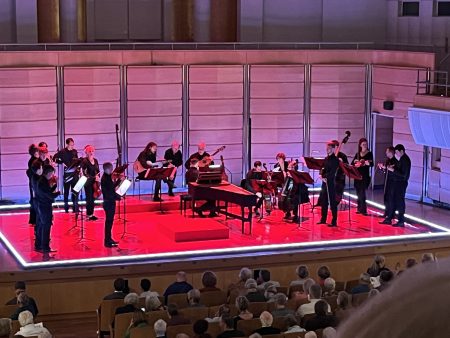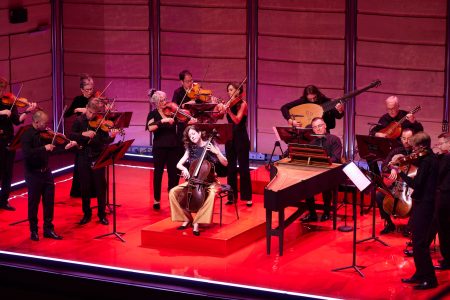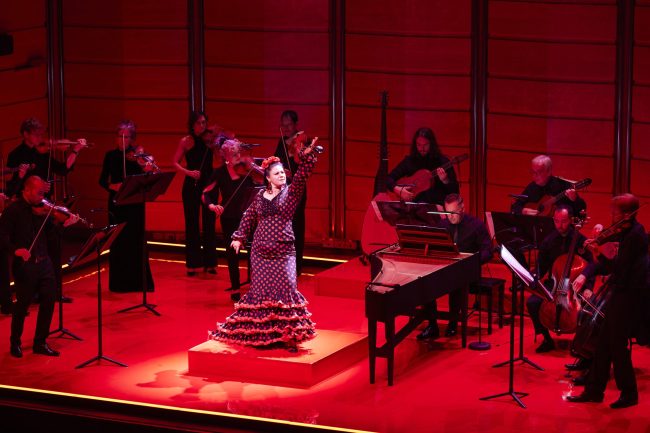The Australian Brandenburg Orchestra performs the music of Luigi Boccherini and Giovanni Sammartini with guest soloist Elinor Frey (period cellos) at the City Recital Hall – Friday 24 February 2023.
Reviewed by Paul Neeson (Arts Wednesday)

In a Spanish themed concert, the stage was dressed in vivid red to suit the evening. A lighting bar standing 10cm high on the floor, framed the stage like a Velasquez painting, changing colour throughout the performance to match the mood.
The Brandenburg Orchestra took to the stage stepping carefully over the lighting, (how did that get past OH&S?) and the audience hushed in eager anticipation.
We start on the streets of Madrid with Boccherini’s evocative piece, La Musica Notturna delle strade di Madrid. This work could have been written just as easily for a film as the concert hall because the action being portrayed is readily recognised: from the church bells in the Ave Maria, the singing and dancing in the tavern and to the night watch regiment approaching, passing and fading into the distance. The latter adeptly employing the well-worn classical form of theme and variation.
But it is the joy of Boccherini’s story telling that shines through at all times. An Italian composer living in Spain, he must have been inspired by the lust for life and occasion expressed by the Spaniards in every aspect of their daily life. And all that sun. You can almost taste the ripe orange juice seeping off the manuscript.

Spanish Steps (photo Keith Saunders)
Boccherini was a virtuoso cellist and wrote prolifically for his instrument, no doubt for his own performance to sure up his position at the Aranjuez court of the Infante Don Luis, younger brother of the king of Spain. Guest soloist, Elinor Frey entered the stage for Boccherini’s Cello Concerto No.9, gingerly stepping over the lighting bar, the crowd hoping she wouldn’t trip and damage her instrument. A technically difficult work, Elinor Frey seemed to struggle with its challenges on her period cello. Her tone was thin, except in the lowest register, and in the faster sections the higher notes all too often slipped off pitch. A disappointing end to the first half that let the reputation of the orchestra down.

Spanish Steps (photo Keith Saunders)
After interval a splash of colour lit up the stage in the form of Flamenco dancer and castanet soloist Yioda Wilson. Her slow flamenco dance was arresting as it built in volume and tempo. This lead seamlessly into the Grave Assai and Fandango from Boccherini’s Guitar Quintet in D major. A little theatrical and kitsch you may ask, but well-justified by Boccherini’s score that specified the use of castanets, which Yioda performed expertly.

Elinor Frey (cello) (photo Keith Saunders)
Elinor Frey returned to perform Sammartini’s Concerto for Piccolo Cello, a smaller version of the instrument. Somehow this instrument suited her fingers much better than the larger one, and she mastered the technical difficulties with ease. And her pitch remained true throughout. Musically, this was from a previous generation, and the sound world had remnants of the Baroque music of Vivaldi, Sammartini being one of those composers who bridged the transition from Baroque to Classical.
But the finale. Wow. La Casa del Diavolo from Boccherini’s Symphony in D minor was a showcase of virtuosity and fireworks. Artistic Director, Paul Dyer, took on board the composers Allegro assai con moto tempo marking to heart and ran with it with gusto. It was one of those knife edge performances that had you holding your breath as you wondered when the band would fall off the rails, Paul Dyer heroically conducting from the harpsichord while simultaneously banging out fistfuls of notes. But no, they hung on for grim life as the Devil harangued them with his relentless diabolic semi-quavers to bring the concert to a thunderous close with faultless timing and precision. We collectively released our breath we’d been holding at last.
The audience went wild. What a satisfying opening to the 2023 season. Can’t wait for what’s next.
